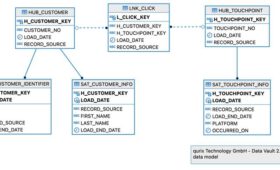Clemence W. Chee, Global Senior Director Data
Companies and organisations today are swimming in data like a boundless ocean. It’s easy to observe the data, but it’s not trivial to grab hold of it and make use of it. How are innovative and successful companies doing it today? How do they see the future of self-service data platforms where business can work with data independently of IT? We asked this question to Clemence W. Chee, Global Senior Director Data, at HelloFresh.
What do you understand by a self-service data platform? Who is the target group here?
A self-service data platform is an end-to-end solution that enables easy access to any data operations for different personas. The different personas can be distinguished between data scientists, engineers, analysts or others. The platform typically includes solutions for the different needs around data integration, data quality, data governance, data exploration and data visualization capabilities. The better the UI/UX for the respective persona, the higher the acceptance of the solution.
It allows users to prepare data, uncover insights, and share findings to drive decisions. At the current state of the data ecosystem, most solutions are designed for data engineers to enable quick and easy access, analyse and share data, and provide the necessary governance and security to maintain data integrity. From my perspective, it’s of upmost importance that the actors (in cross-functional teams) can maximise their flow in collaboration.
Clemence W. Chee
The term data product is an attempt to make data more tangible for business departments but also for IT. What is data product for you?
There are different understandings, depending on the audience and the data maturity of the organisation. First, it’s important to get a holistic understanding of a data value chain. In other words, the supply chain of the data. Data is produced and consumed in different ways for different purposes. Hence data in most cases is not a directional flow, but rather a bi-directional flow where a data consumer becomes a data producer and vice versa. This means a data product can be any system or application that delivers value from data. It can be sources and tools that eventually are used by an end-consumer in data analysis, data mining, machine learning, AI – you name it. It’s a mindset change in terms of getting a product mindset when working with data. With higher product quality, comes higher data quality which eventually maximises value for the business.
Clemence W. Chee
What exactly do you expect from the use of such platforms? What problem do you want to solve with Self-Service Data Platform for HelloFresh?
A SSDP can help to unlock the potential of data by providing a single platform, a centralised, secure and accessible interface for users. This helps to create data products quickly and at the same time not to lose the power of innovation. Accessibility to data also means a higher degree of speed of innovation. However, it’s important to have governance and security features in place to assure the quality of deployments. The improvement on collaboration between departments, as a all data is stored in one central accessible location with a standard interface, it accelerates product development and reduce time to insights.
Clemence W. Chee
Where do you see the biggest challenges in introducing such platforms in companies?
One of the greatest challenges as a data leader is not technical. Just the implementation of a SSDP is not the biggest challenge. The cultural transformation that need to take place for data to be effectively used is the biggest. Ingrained systems and processes are often difficult to change, not everyone understands the added value of data yet. The big challenges are Data Education, Cultural Change and Taking away the fear of working with data. To solve this, you have to take people by the hand and go through their use cases. If you introduce such a SSDP, then companies should do Lighthouse projects and continuously report on the smaller success steps. These commercial project teams should be accompanied by experts for 1-2 months.
Clemence W. Chee
When you say „to simply provide use data“ then what exactly does this „provide“ look like? What practically has to be made available for you?
Each persona has different needs, so several solutions may be necessary. But if you imagine any kind of product – the most successful products around us have similar traits. One of the traits is the easiness of use. It should be easy for everyone to work together and collaborate. Besides easy access to data and metadata, an SSDP must also provide context and semantics.
Clemence W. Chee




